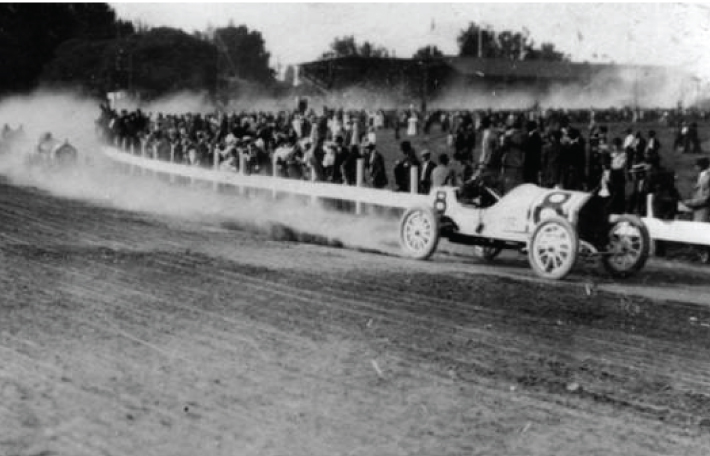
With race cars speeding through the streets of Long Beach this weekend, we take a look at some of the long-lost raceways of Southern California.
First in Southern California
Horses, autos and motorcycles would all race at the first Ascot Park when it opened in 1903 in L.A. Its first auto race was held in 1907, and its final one in 1919.
The Legion Ascot Speedway, built in 1924, was closed after the grandstand burned down in 1936. The speedway was near what is now Lincoln Park, a little east of the 5 Freeway and a few blocks north of the 10 Freeway.
The Legion Ascot Speedway was a five-eighths mile, banked dirt oval. The track had a deadly reputation and was nicknamed the “killer track” after 24 people died there in a dozen years. This could be the reason the track is also known as the first to use safety helmets.
Women were banned from racing by AAA in 1909, but some found ways to compete.
The most famous of the four Ascot racetracks was Ascot Park, which opened in 1957.
Ascot Park Speedway near Gardena in 1972. The track held numerous United States Auto Club national tour races and three NASCAR Grand National races. The Turkey Night Grand Prix was held at the track for several decades. It had seating for 7,500. It was built near Carell Speedway, which closed in 1954 for construction of the 91 Freeway.
The track hosted all kinds of races for 33 years, from sprint races to figure 8s. Daredevil Evel Knievel did his first public stunt when he jumped six cars on his motorcycle. In 1967, Knievel made his first national television appearance at Ascot, jumping 15 cars on ABC’s “Wide World of Sports.”
First in the world
By 1910, vehicle speeds were over 80 mph.
The Los Angeles Motordrome in Playa del Rey was an elevated, wooden-board track that opened April 8, 1910. It was not the first racetrack in L.A. but it was the first of its kind in the world. The 1-mile oval could host 12,000 spectators and was designed by velodrome (bicycle track) engineer Jack Prince.
The track was approximately 45 feet wide. It’s estimated to have required more than 2 million square feet of lumber.Sportswriters nicknamed the track “the pie pan.”The track was estimated to have banking of at least 18 degrees (by 1912, Prince had a track in St. Louis with 62-degree banks). The Motordrome was successful for three years and hosted both automobile and motorcycle races.
A fire broke out under the Playa del Rey track in August 1913, and the damage was so bad the owners opted not to rebuild.
The Motordrome was not the only L.A. track to be abandoned due to fire.
Supersizing it
When you think of Beverly Hills, does the image of a race car come to mind? If it were 1920, that might be the case. Prince designed a 1.25-mile wooden track that featured 35-degree turns on a large plot of land where the Beverly Wilshire Hotel is today.
The track could host 50,000-70,000 fans, and the winner of the first race in 1920 averaged 103 mph over 250 miles – faster than the Indianapolis 500 winner that year.
The Beverly Hills Speedway was closed by February 1924 when the land became more valuable for real estate development. The track owners built a new venue in Culver City that opened in December 1924 and lasted until 1927, when its real estate value grew.Just as tracks in Los Angeles gave way to development, so did the ones in San Bernardino and Riverside counties. The Riverside International Raceway and the Ontario Motor Speedway sites are occupied by malls, warehouses and homes. The track in Riverside was open from 1957-1989, and the Ontario track opened in 1968 and closed in 1980. Ontario was the first track to host stock cars and open-wheel racing (on oval or road coarse) and have a drag strip. The Auto Club Speedway in Fontana, which opened in 1997, is about 2 miles from the old Ontario Motor Speedway.
Fighting to race
Perris Auto Speedway was built in 1996 and is a half-mile clay oval on the Lake Perris Fairgrounds. There is a campaign called #saveperris since the track and other businesses around it are in a legal battle with the state over a Perris dam construction project.
Stripping it down
Drag racing has its roots in Southern California deserts starting in the 1930s. After World War II it grew in popularity, and the National Hot Rod Association was founded in 1951 by Wally Parks.
Santa Ana Drag Strip, at what is now John Wayne Airport, is recognized by the National Hotrod Racing Association as the nation’s first commercial drag strip.
The drag strip opened June 19, 1950, and operated until June 21, 1959, with races Sundays (except for Mother’s Day) from dawn to dusk.
The strip would charge a fee for entrance, and almost anyone was welcome to compete. Some would come in their personal rides; others would customize cars specifically to race on Sundays.
Sources: Los Angeles Public Library, FirstSuperspeedway.com, The Daily Breeze, El Sereno Historical Society, Dragstriplist.com, NHRA Museum, Speedwayandroadracehistory.com, PerrisAutoSpeedway.com
